Comparative Mythology: Irish Giants versus Greek Titans—An Analysis of Legendary Beings

Updated On: April 23, 2024 by Raghda Elsabbagh
Comparative mythology reveals the underlying threads that connect cultures separated by both time and geography. In comparative mythology, we explore giants in Irish myth alongside the titans of Greek lore, uncovering similarities and contrasts in their tales. The Irish giants, formidable beings in their own right, stand as central figures in the island’s mythology and are deeply embedded in the fabric of Celtic folklore. The titans, on the other hand, are pre-Olympian deities in Greek mythology who were critical to the cosmological framework of the Greeks, often representing primal concepts and the natural world.
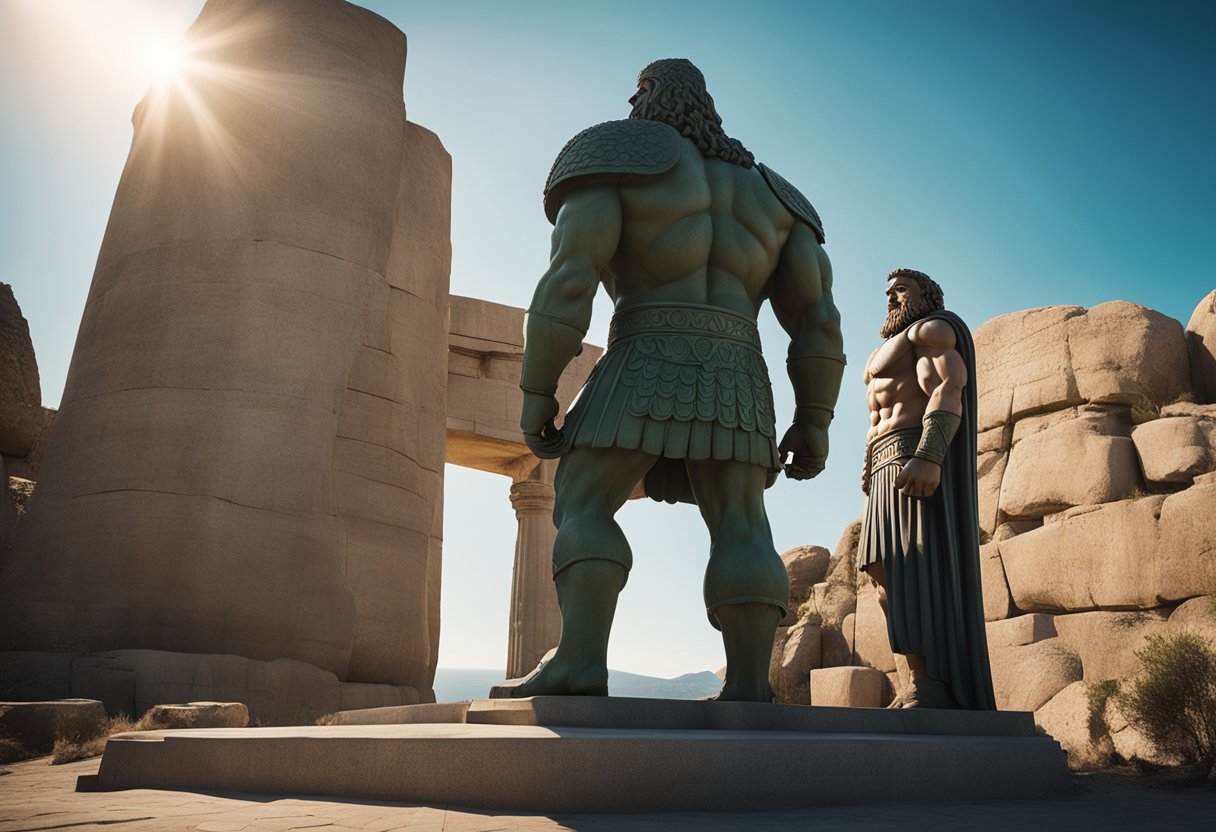
Considering the mythological origins and family trees of these two groups, there’s an intriguing structural parallel that gives rise to a wealth of archetypal figures iconic within their respective mythos. When we examine their epic battles and conflicts, prominent figures arise, such as the Greek Titan Cronus and the Irish giant Fomorians, each playing pivotal roles in mythical narratives that underscore their influence on human affairs and nature itself. The physical descriptions and symbolic representations of these beings create a palpable impression of their might and roles within a mythological context, lending them a sense of majesty and terror in literature and art throughout the ages.
Table of Contents
Mythological Origins and Family Tree
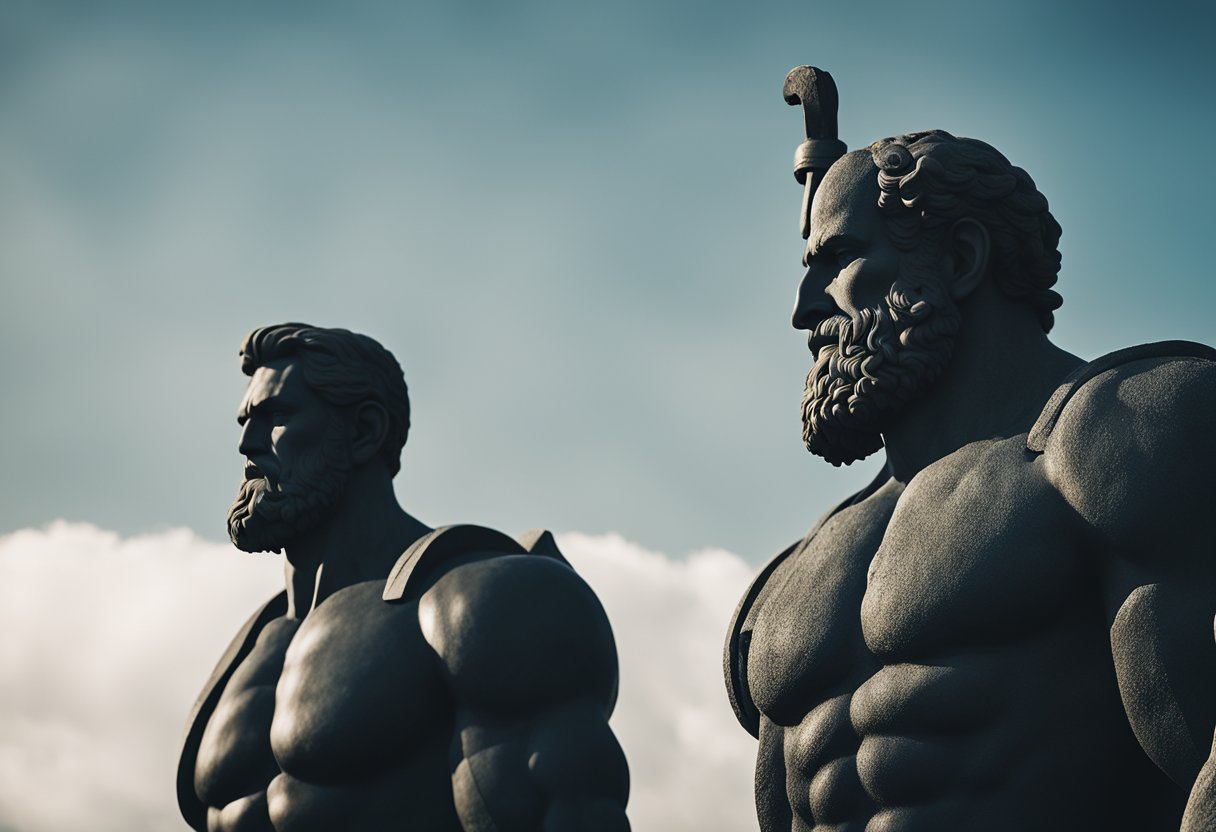
As we explore the mythological origins and family trees of these ancient cultures, it’s crucial to recognise the foundational deities that set the stage for the tales of giants and titans in Irish and Greek traditions respectively.
The Primordial Deities of Greek Mythology
In Greek mythology, the cosmos was created out of Chaos—a void state from which the first entities emerged. Among these were Gaia, or Earth, and Uranus, the sky. Their union produced the Titans, the elder gods, who were overthrown by their offspring, the Olympian gods, in a series of battles known collectively as the Titanomachy. Theogony, a poem by Hesiod, chronicles the genealogy of these gods.
Gaia (Earth)
- Marriage to Uranus (Sky)
- Children: Titans, Cyclopes, and Hecatoncheires (hundred-handed giants)
- Marriage to Uranus (Sky)
Titans
- Notable Figures: Cronus, Rhea, Oceanus
- Legacy: The parents of Olympians
Ancestral Figures in Irish Mythology
Irish mythology presents a different set of primordial figures, with an emphasis on the natural elements of the island. The supernatural race of the Fomorians is somewhat analogous to the Greek Titans. Described as giants or sea raiders, they represent the powers of chaos and wild nature. The Tuatha Dé Danann, the pantheon of Irish gods, eventually defeated them, much like the Olympians overcame the Titans.
- Fomorians
- Represent: Chaos, wild nature
- Encounters with: Other supernatural Irish races
By delving into these foundational myths, we uncover the cultural significance of the natural world to our ancestors, whose stories still resonate with us.
Epic Battles and Conflicts
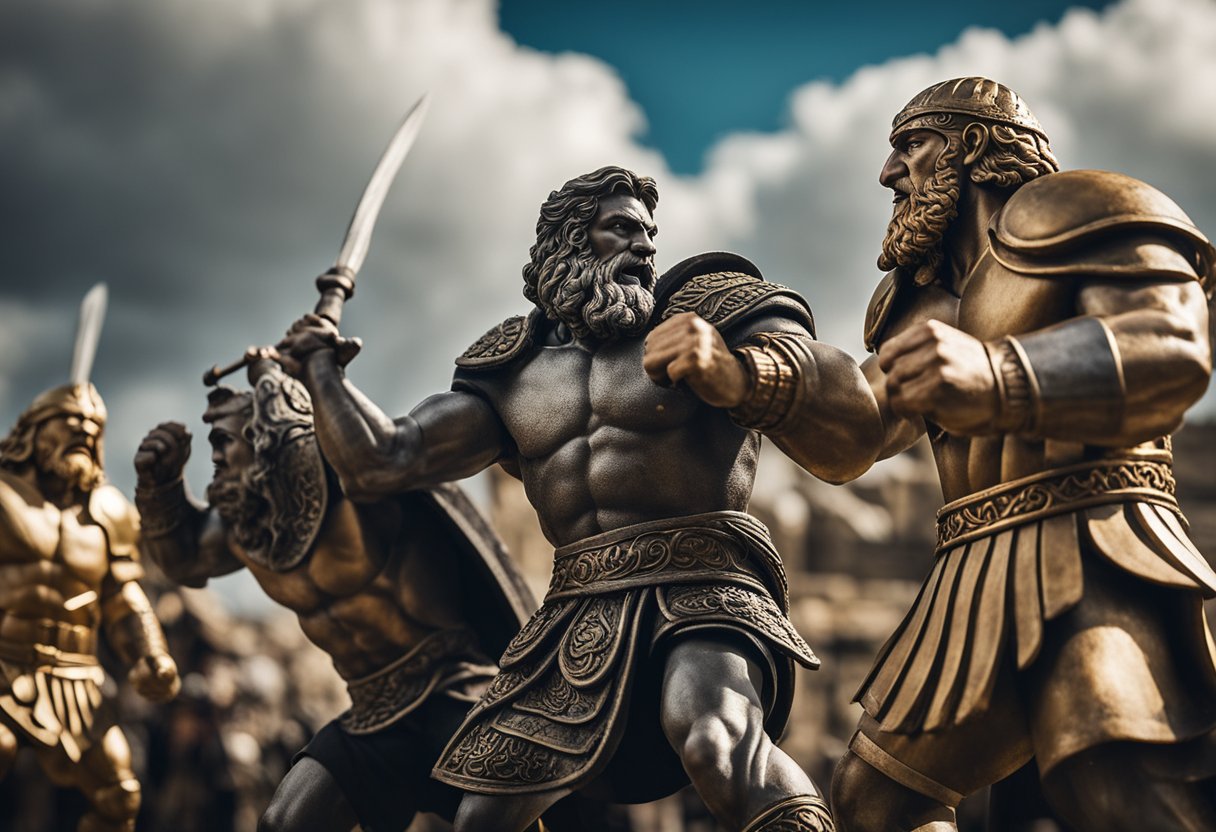
In the annals of mythology, both Irish and Greek legends are replete with formidable battles that shaped their worlds. We’ll examine the Titanomachy and Gigantomachy, significant wars that depicted the struggle for supremacy between primordial forces and deities.
Titanomachy: The War of the Titans
The Titanomachy was a cataclysmic conflict that raged between the older gods, the Titans, and the younger deities, the Olympians. The Titans, born of Gaia and Uranus, ruled during the Golden Age, until Zeus, wielding his formidable thunderbolt, led a rebellion against them. This ten-year war, which unfolded on the cosmic battlefield of Ancient Thessaly, culminated in the victory of the Olympians, who would then establish their reign on Mount Olympus.
Gigantomachy: The Earthly Giants’ Revolt
Parallel to the Titanomachy in Greek mythology is the formidable Gigantomachy, the revolt of the Giants against the Olympian gods. This struggle ensued when the earthborn Giants rose up, seeking to claim power from Zeus and his kin. The Olympians, armed with their divine prowess and the might of Zeus’s thunderbolt, ultimately quelled the Giants’ revolt. This series of battles reaffirmed the rule and authority of the Olympians, cementing their position as the paramount gods within Greek mythos.
Prominent Figures and Character Comparisons
In this exploration, we compare the towering deities and legendary rulers from Greek and Irish mythology, revealing their roles and attributes.
Leaders of Myths: Zeus and the Irish King
In the pantheon of Greek mythology, Zeus stands as the omnipotent ruler of Mount Olympus. As the king of the Olympian gods, Zeus wields the thunderbolt and presides over the skies and the natural world. His role marks his dominion as the arbiter of justice and order among gods and humans alike.
Contrastingly, the kings in Irish mythology, although not possessing the divine authority of Zeus, still hold significant power within the tales of the Emerald Isle. Among these, none is more renowned than the Tuatha Dé Danann king, a caste of pre-Christian gods that are central to Irish lore. The might of the Irish king is steeped in enchantment and sovereignty, commanding respect and loyalty from warriors and citizens.
Zeus’s counterpart in Irish mythology could be considered, to an extent, the figure of Lugh, a member of the Tuatha Dé Danann known for his mastery of multiple skills. While not a direct correlation, as leadership within Irish mythology is often more fragmented and less absolute than the Greek’s centralised god-king, the comparison showcases varying aspects of the mythological rule.
With Zeus’s counterparts, such as Hera—his consort and goddess of marriage, and Apollo—his son and god of music, prophecy, and healing, the Greek hierarchy projects a family dynamic that influences the entirety of creation and humanity. Hera’s role as Zeus’s wife adds a layer of complexity to the Olympian narrative, with stories often depicting their celestial relationship and its ramifications for both gods and mortals.
The giants of Irish mythology and the Titans of Greek tradition serve as primordial forces that are overtaken by a new order. In Greece, the Titans, like Cronus, the father of Zeus, are eventually subdued by the Olympian gods in a cycle of struggle and usurpation that underpins the Greek understanding of an ever-changing cosmos. The Irish giants, although varied in depiction, similarly interact with the gods, such as the Fir Bolg challenging the Tuatha Dé Danann, echoing the theme of a transformative and tumultuous mythology.
Our comparison illustrates that, while the Greeks and the Irish carved distinctly different mythological canons, the resonance between their characters and stories highlights a shared heritage of humanity’s attempts to fathom the cosmos and society’s place within it.
Mythological Themes and Cultural Impact
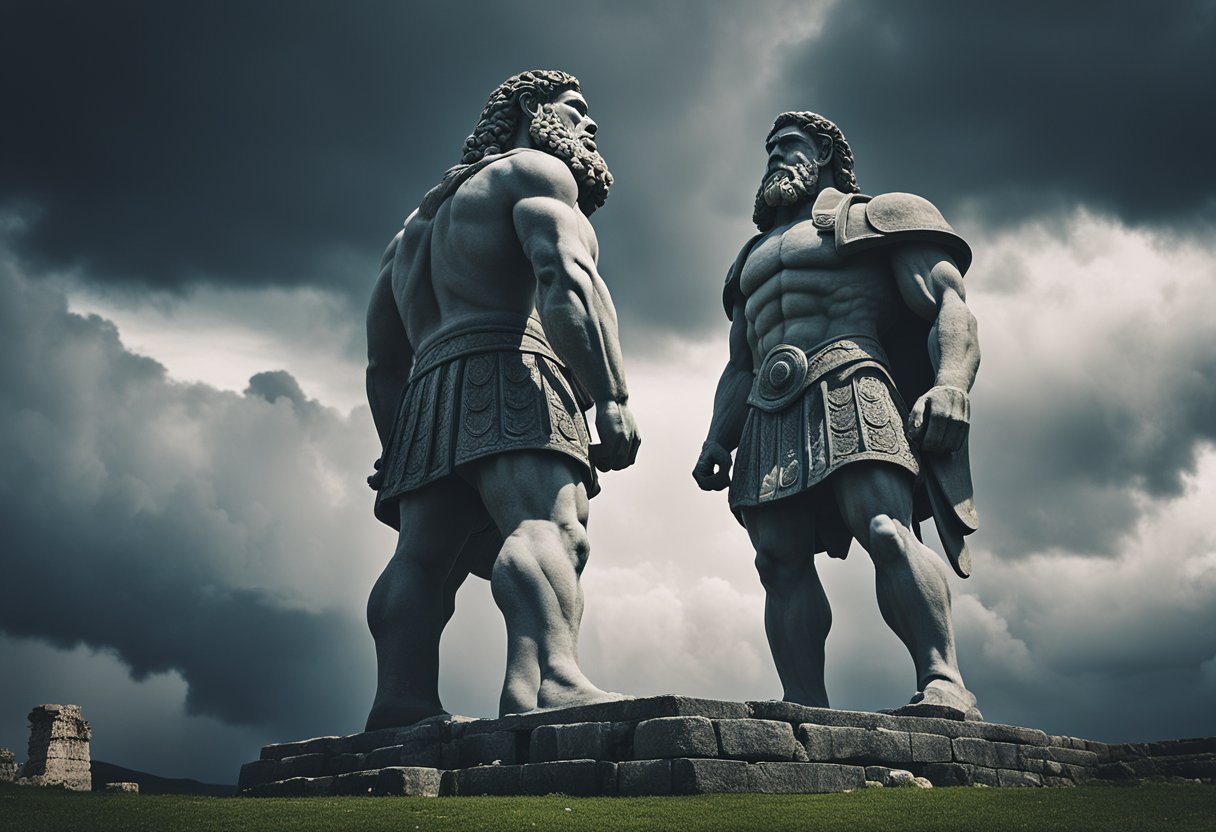
Mythology serves as a fundamental pillar through which we can trace the evolution of cultures and the human psyche, specifically within frameworks like the robust legends of Irish giants and the powerful narratives surrounding Greek titans.
Creation, Destruction, and Kingship
Both Irish and Greek mythologies offer intricate narratives about the world’s creation, aspects of destruction, and the role of kingship. In Irish legend, the Formorians were known to represent chaos and wild nature. The defeat of this giant race by the Tuatha Dé Danann symbolises order over chaos, an echo of the Olympian gods’ triumph over the Titans in Greek lore. Kingship is likewise exemplified by figures such as the Dagda or Zeus—both hold sovereign roles.
Fertility, Earth, and Agricultural Symbolism
Fertility, the Earth, and agricultural symbolism are embodied within myriad elements of these legends. The Greek goddess Demeter, tied to the grain and harvest, shares her symbolism with the Irish goddess Danu, the namesake of the Tuatha Dé Danann, who are linked to growth and fertility. Through these figures and their stories, we gain insight into the ancient peoples’ reverence for the land’s bounty.
Physical Descriptions and Symbolic Representations
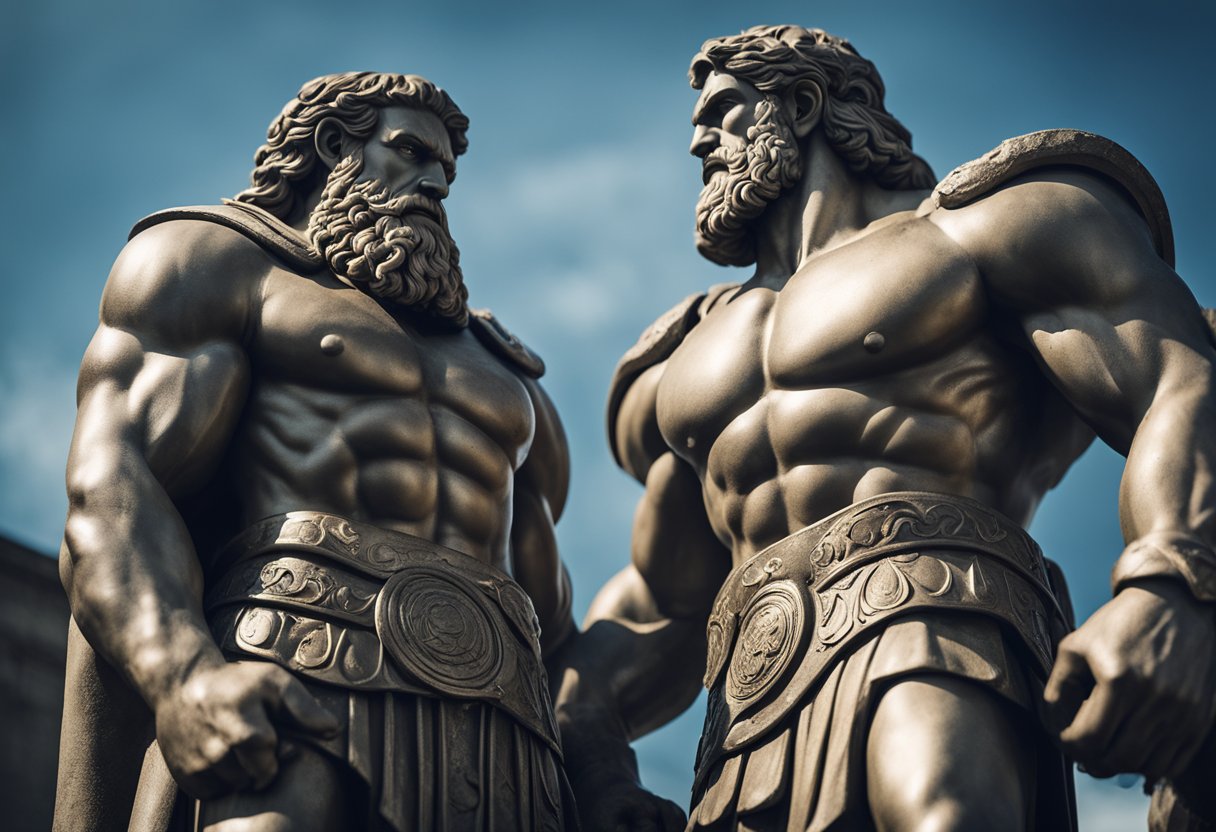
In comparative mythology, the physical attributes and symbolic representations of divine or semi-divine beings often reflect their role in the universe and their cultural importance. Let’s explore the nuances of Greek Titans and Irish Giants.
Titanic Attributes and Their Meanings
Rhea: Known for her connection to the earth and motherhood, Rhea’s representation is often tied to the fertile ground and the nurturing of life. She symbolises the continuous cycle of growth and decay.
Atlas: This Titan, burdened with the weight of the sky, embodies the enduring nature of the mountains, an unwavering symbol of strength and perseverance.
Poseidon: With his trident, Poseidon rules the oceans and represents unfathomable depths and the dual nature of water—both life-giving and treacherous.
- Attributes: The colossal stature and immense strength of the Titans mirror the natural elements they personify, such as the vast mountain ranges and the boundless ocean.
- One-arm: While no ancient Greek Titan is specifically known for having one arm, such physical traits in myths can signal unique powers or a symbolic loss.
Giants as Symbols in Irish Lore
Giants: In Irish mythology, giants are often seen as primal forces of nature. Their huge size and strength connect them to the earth—its rocky outcrops and the fertile green hills.
- Thor: Not an Irish deity but a thunderous figure in Norse mythology; he is similar to Irish giants in that he is connected with natural phenomena—the thunder is his voice, the lightning his hammer’s strike.
- One-arm: The image of a one-armed giant can signify a loss or a deficiency, perhaps indicating that even the mighty are not whole or are disadvantaged in some way.
We can see that both Greek Titans and Irish Giants are much more than mere characters in myths; they represent key elements of the natural world and human emotion, symbolising primordial power and the forces that shape our existence.
Territories and Powers
In this section, we explore the remarkable realms and abilities attributed to two distinct groups of mythological beings: the ancient Greek Titans and the Irish Giants. We’ll delve into the dominions they preside over and the powers they wield.
Dominions of the Titans
The Titans, a primaeval race of powerful deities in Greek mythology, held sway over vast aspects of the cosmos. Tartarus, part of the Underworld, served as a prison for these deities, specifically for those who opposed Zeus. Here, the Titans were confined after their defeat in the war against the Olympians.
Hyperion, father of the sun, the moon, and the dawn, commanded the celestial light, while his sister Tethys governed the fringes of Oceania, the ocean, which was believed to encircle the world. Alongside them, they oversaw the natural phenomena that occurred above and within the sea. The Titans were closely connected to primordial elements and cosmic principles, their powers manifesting in the raw forces of nature.
Realms of the Irish Giants
In Irish mythology, the Giants were robust and formidable beings, often linked to natural landscapes within the country. While not specifically detailed in the records, connections can be drawn from their tales to potent regions. The Fomorians, a supernatural race, were akin to sea deities and giants, thought to have emerged from the depths of the earth or the sea, claiming sovereignty over chaos and the wild forces of nature.
These Irish Giants were renowned for their association with the land, dwelling within the dense forests and mountains of Ireland. They played pivotal roles in myths shaping the cultural and natural landscape; their actions intertwined with the terrain, causing upheavals that were believed, in some tales, to result in features such as valleys and hills. Notably, the Tuatha Dé Danann, also seen as deities of craft and magic, ruled over Mount Olympus-like domains, with fortified dwellings on high ground suggesting a celestial connection akin to that of their Greek counterparts.
Comparative Mythology: Mortal Interactions and Influence
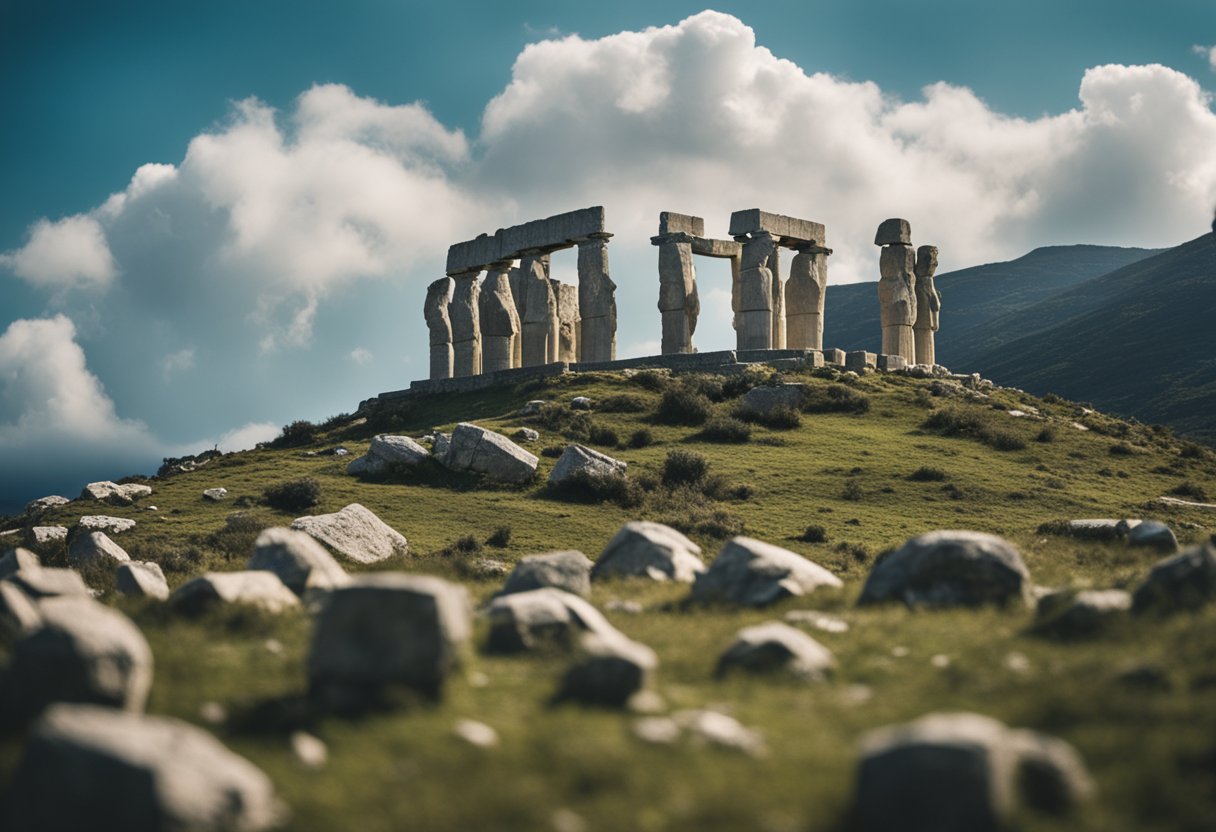
In our exploration of comparative mythology, particularly concerning Irish giants and Greek titans, we observe notable interactions between these colossal figures and humans. These engagements and interventions have significantly shaped the mythos and human experience within each culture.
Human Engagements with Giants
Giants in Irish mythology are often seen interacting with mortals. Tales chronicling the adventures of Finn McCool, a revered giant in Irish lore, depict him working alongside mortals. These collaborations ranged from building causeways to engaging in battles. Giants weren’t always antagonistic to humans; rather, they frequently shared relationships that influenced Ireland’s mythological landscape.
Titan Involvement in Mortal Affairs
In Greek mythology, the Titans had profound impacts on mortal lives. For instance, Eos, the titaness of the dawn, is known to have taken a mortal, Cephalus, as her lover. Heracles, while not a titan himself, was deeply entangled in their world, dealing directly with Titan offspring and deities like Artemis. Titan influences, such as those of Coeus, Crius, and Iapetus, reached into mortal experiences through direct interaction and tutelage, revealing a complex tapestry of relationships between gods, titans, and humans.
Cosmology and the Structure of Myths
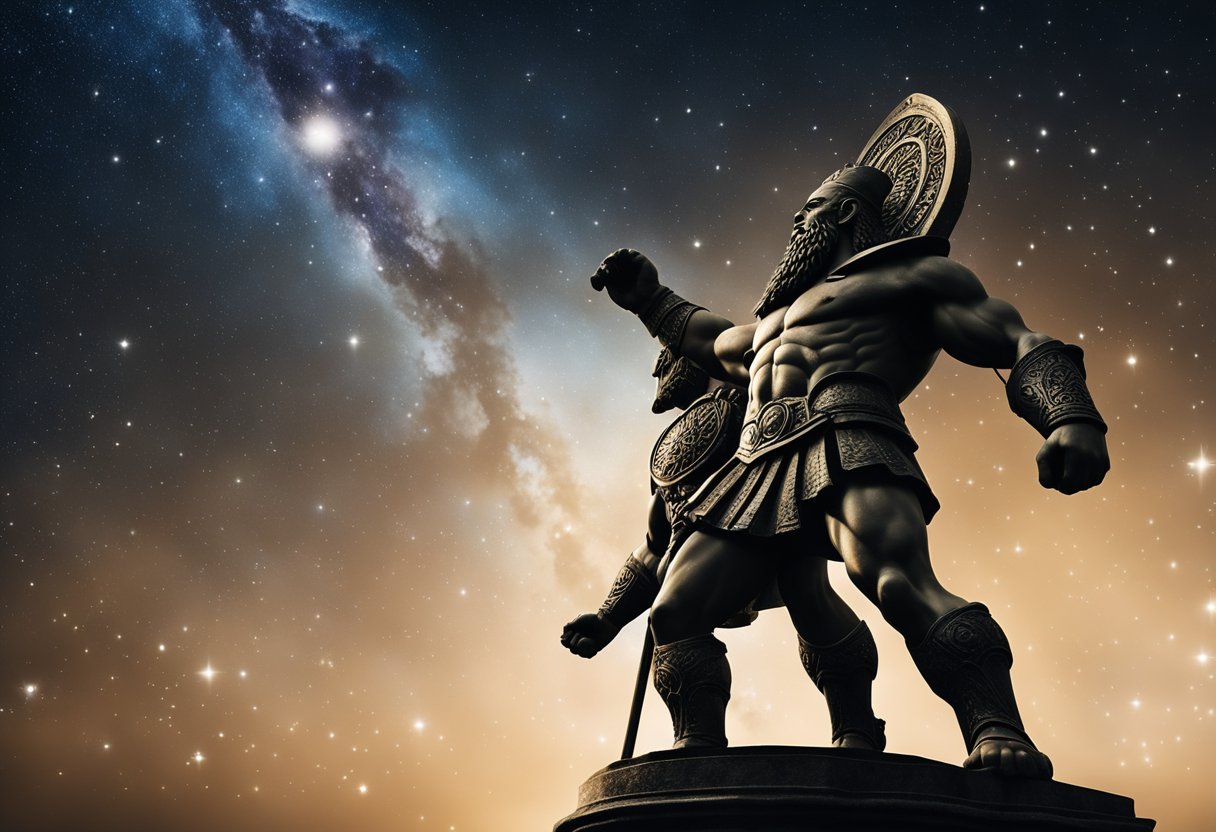
When we explore comparative mythology, the concepts of cosmos and chaos are crucial in understanding the structural foundation of various creation myths. Irish giants and Greek titans exemplify powerful archetypes within their respective mythologies, serving as agents of order or disorder.
In Irish myth, giants are often seen as the shaping forces of the land—Fionn mac Cumhaill is said to have built the Giant’s Causeway. Their size and strength embody the physicality of the cosmos as they interact with the world to create features of the landscape and thus impose a form of order from the chaos.
Conversely, in Greek mythology, the titans, who preceded the Olympian gods, exemplify primordial entities born directly from Chaos. They represent the raw forces of nature, and through their overthrow by the Olympian gods, a new order of the cosmos is established, reflecting the transition from the unformed to the structured world.
The work of Mircea Eliade highlights these mythic structures and their significance. He suggests that such myths serve as a reflection of the perpetual tension between the sacred and the profane—between structured cosmos and ever-present chaos.
| Irish Giants | Greek Titans |
|---|---|
| Order through creation | Primordial, powerful forces |
| Landscape shaping | Precursors to the cosmic order |
Our understanding of these entities within their mythological contexts illustrates the universal themes of order and origins that resonate across cultures. Myths, through their structures, provide a deeper insight into the collective psyche and underscore the continual human quest to make sense of our place in the universe.
Legacy and Retellings in Modern Media

Exploring the profound impact these ancient narratives have had on culture, we uncover how the powerful legacies of Irish giants and Greek titans continue to be reimagined in modern media.
Classical Texts and Interpretation
Myths such as the Titanomachy and Gigantomachy depicted in Hesiod’s Theogony serve as foundation stones for classical literature. These epic battles culminate in the defeat of the primordial Titans by the Olympians, and in Irish lore, the triumph of Tuatha Dé Danann over the giant-like Fomorians echoes similar themes of cosmic order over chaos.
The practice of comparative mythology has brought new dimensions to the interpretation of these texts, highlighting their thematic resonance across cultures. This inquiry delves into mythic parallels and the human condition reflected in these legendary conflicts.
Modern Reimaginings of Mythic Giants and Titans
In recent times, literature and other forms of media have witnessed a resurgence of fascination with mythic beings. For instance, interpretations of the Titanomachy have appeared in novels and films, providing contemporary audiences with a lens to view these ancient conflicts.
- Modern Reimaginings:
- Literature: Madeline Miller’s The Song of Achilles infuses new life into the Greek myths with a focus on the Trojan War, often drawing comparisons to titanic struggles.
- Television: TV series like Ragnarok skillfully weave Norse giants into a modern setting, demonstrating the narrative’s adaptability.
Moreover, comparative mythology has made its way into popular culture, with media like the Harry Potter series drawing inspiration from a varied mythological tapestry, connecting ancient myths with modern audiences. Irish giants are revisited in works that reflect Ireland’s rich mythological heritage, amplifying their relevance in today’s media-saturated landscape.
Interconnectedness Across Mythologies
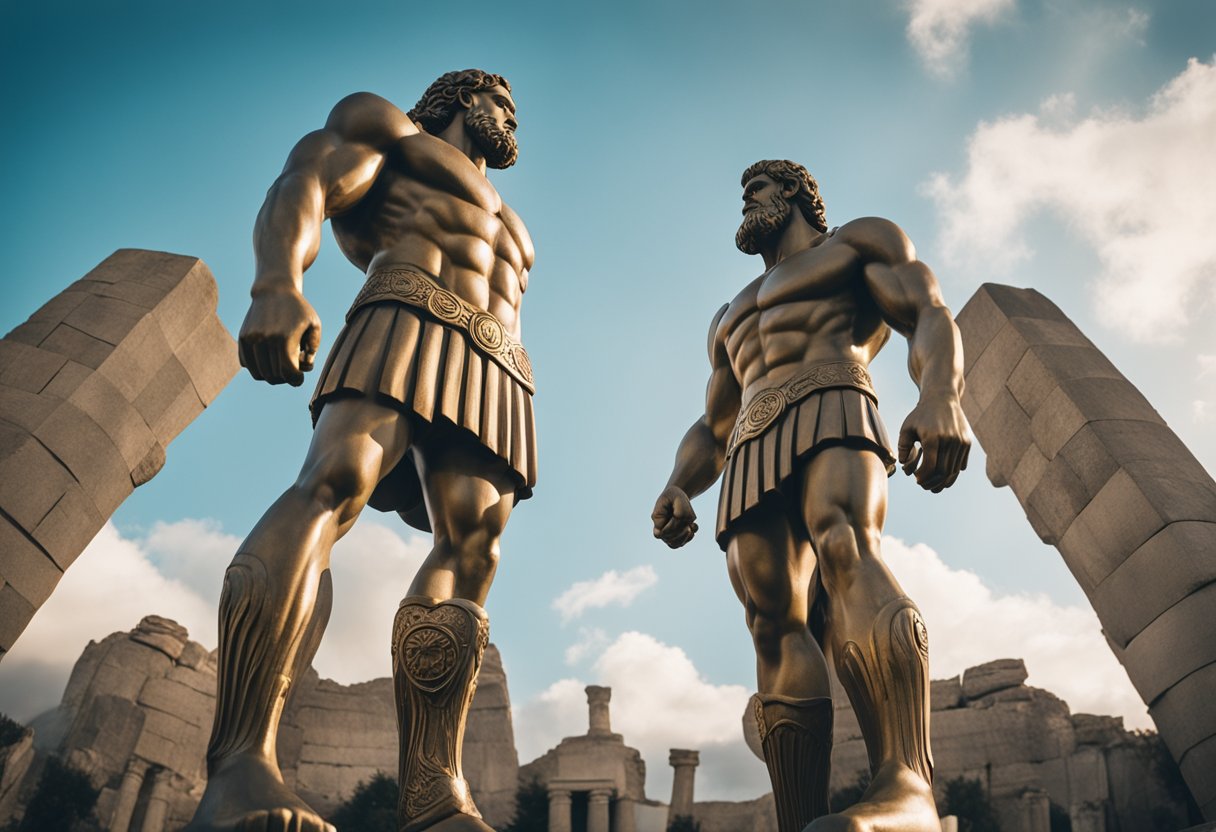
Mythologies, though distinct in their narratives and figures, often share a remarkable interconnectedness that resonates across different cultures and continents. We’re about to explore the profound connections between the mighty beings of Greek and Irish myth, along with shared archetypes seen in Norse and Celtic lore and beyond.
Greek-Titan Influence on Other Cultures
The Titans of Greek mythology have left a potent legacy influencing numerous other cultures. For instance, looking at Celtic myth, we can draw parallels between the Titans and Irish giants like those found in the Fenian Cycle. Titans like Cronus or Atlas embody themes of power, order, and the primordial nature of the cosmos, much like the Formorians in Celtic stories, who represent chaos and wild, natural forces.
We also see echoes of Titan-like figures in Norse mythology, with beings like Jörmungandr, the world-serpent, and Ymir, the first giant, both of whom have mythic roles similar to Greek Titans. Ares, the Greek god of war, shares aspects with Norse deities such as Thor, both embodying the warrior archetype in their respective cultures.
Shared Archetypes: Norse, Celtic, and Beyond
Across mythologies from Asia to Africa and beyond, shared archetypes are a testament to our collective human experience. The figure of the divine warrior, seen in Greek mythology through gods like Ares, is mirrored in Norse lore by gods such as Tyr and Thor, each embodying the values and warfare ethos of their culture.
Family plays a central role in these mythologies. We see deities like Dionysus, who undergoes personal trials and transformations, reflecting the importance of personal struggle and growth—a recurring theme that extends to Celtic legends, where family ties often drive the narrative and influence events.
By embracing the interconnectedness of these myths, we enrich our understanding of humanity’s diverse narratives, drawing closer to a shared human heritage that spans across our collective past.
Frequently Asked Questions
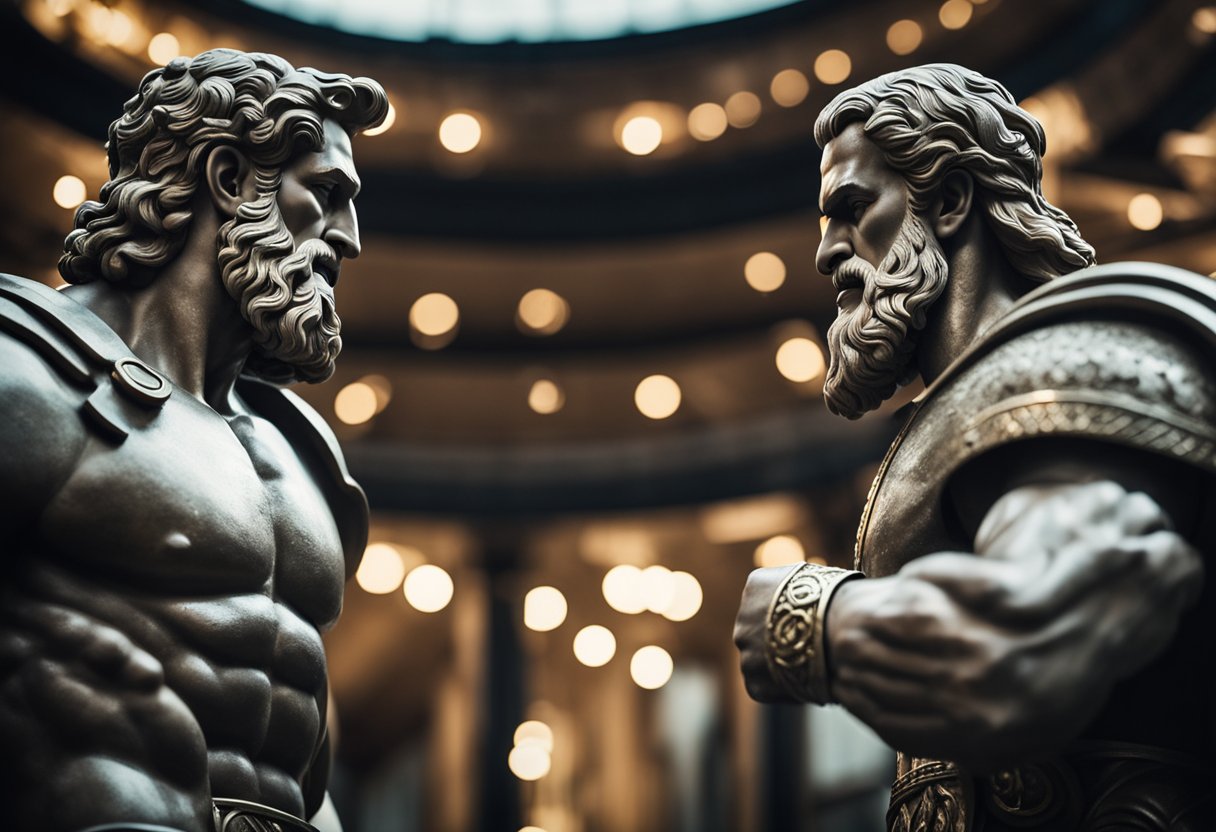
Diving into our exploration of figures of lore, we find a rich tapestry within Irish mythology, populated with towering personages akin to the grand beings of Greek myth. Our focus here is a comparative look at these fascinating entities, addressing the common queries surrounding them.
Who are the central giant figures within Irish mythology?
In Irish mythology, the Fomorians stand out as a race of supernatural beings often depicted as giants, with the likes of Balor of the Evil Eye being eminent among them. Another notable figure is the Gargantuan hero Cú Chulainn during his warp-spasm, embodying the colossal might typically attributed to giant kin.
How does the role of giants in Irish myths compare to that of Titans in Greek myths?
While Irish giants often personify natural elements and chaos, similar to the Greek Titans, they don’t typically hold the same foundational role in the creation of the cosmos. The Titans in Greek myths are pre-Olympian gods who directly birthed the Olympian gods and set the stage for the cosmic order.
Is there an event similar to the Gigantomachy in Celtic mythology?
The Irish myths recount battles with formidable giants, but there isn’t a direct parallel to the Gigantomachy — the climactic conflict between the Olympian gods and the Giants in Greek mythology. Celtic myths portray various skirmishes with otherworldly beings rather than a singular cosmic battle.
In what ways do Irish mythological tales of giants differ from the stories of the Greek Titans?
Characteristically, Irish giants are integral to the earth and landscapes, often depicted as heroes or antagonists in cultural narratives rather than creators or precursors of gods. The Greek Titans, on the other hand, are more fundamentally tied to the cosmos’s very structure and governance.
Do myths of Irish giants incorporate themes of creation and destruction akin to those associated with Greek Titans?
While Irish giants are associated with the shaping of landscapes and legendary feats, their myths don’t typically encompass broad themes of creation and destruction evident in tales of the Greek Titans, who are central to the birth and upheaval of the universal order.
What are the distinctive characteristics that separate the Titans of Greek mythology from giants in other mythologies, including Irish?
The Greek Titans’ distinguishing feature lies in their role as the deities preceding the Olympian gods, embodying archaic powers and principles. In contrast, giants from various mythologies, including the Irish, manifest as vast and mighty entities but lack the Titans’ cosmogonic significance.






